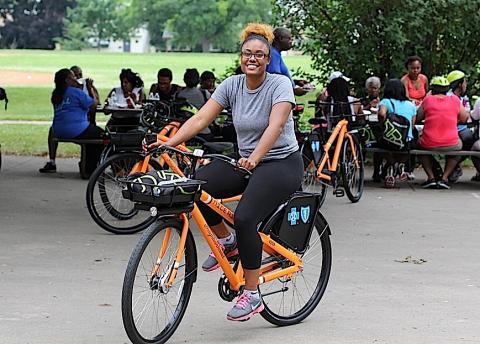
Nice Ride program thrives with UROC’s support

Looking around North Minneapolis, it seems as if bright orange bikes are sprouting up everywhere, and that’s because they are. May marked the second year of the Nice Ride Neighborhood Program, which loans bikes to individuals living in North Minneapolis and South Minneapolis’ Little Earth of United Tribes, as well as the East Side of St. Paul and the Frogtown neighborhood.
Unlike the green bikes offered through Nice Ride’s urban bike share program, the orange bikes are loaned for the entire riding season, May to October. The goal of the program, which is supported by Blue Cross Blue Shield of Minnesota, is to boost ridership in underserved communities where things like safety concerns, lower incomes and a lack of biking infrastructure can discourage people from riding bikes.
More than 250 riders are participating in the program this year, almost double last year’s number, indicating that the project is on the right track. But there is always learning and retooling to be done, and that’s where the University of Minnesota Robert J. Jones Urban Research and Outreach Engagement Center (UROC) comes in.
UROC partnered with the Nice Ride Neighborhood Program last year during the project’s pilot phase. In addition to doing a comprehensive evaluation of the pilot, UROC staff interviewed nearly 100 of the 145 participants, conducted focus groups and attended events to get a sense of how things were going. What UROC found helped shape the positive changes that were made before this year’s launch, says Paul Stucker, coordinator of the Neighborhood Program. “Their feedback was invaluable and thorough because we really got a clear sense of what was working for people and what we needed to improve on,” he explains.
Many participants, for example, said they were happy to have bikes as transportation, especially when biking made it possible to get out and spend time with family and friends. Riders also liked the community building aspect of having more people out and about on orange bikes.
Also popular was the $200 voucher participants receive if they ride their orange bike twice a week and attend at least four of the program’s events. The only hitch, people told UROC’s researchers, were the events themselves. Last year, events were held in conjunction with other community events, which was good, but riders also wanted more varied options that would allow them to qualify for a voucher and gain more riding experiences and knowledge. So this year the program also offered bike shop tours and educational classes such as Rules of the Road and Traffic 101.
Lauren Martin, UROC’s director of research, agrees that the partnership with the Nice Ride Neighborhood Program has been a success and work in ongoing. “At UROC, we are thrilled to partner with Nice Ride and Blue Cross to support the community and promote bike equity. It is a great opportunity for our University of Minnesota student and community researchers on the project to connect, engage, contribute, and learn.”
Program participants are recruited annually in each neighborhood by community partners, including NorthPoint Health and Wellness Center in North Minneapolis and Model Cities and St. Paul Public Housing in St. Paul. Most riders receive their bikes in May at one of many orientation sessions. Information gathered from participants at the end of the season will help determine changes for 2016. “It’s too early to say where and how the program will expand,” says Stucker. “But there are a lot of people working on this and it will be exciting to see what happens.”